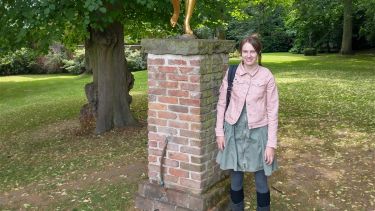In this post, I review a panel discussion titled ‘The Sights of Criminal Justice’ organised virtually by the Centre for Criminological Research (CCR) at Sheffield on 8 September, 2021. The event was chaired by Dr Gilly Sharpe (Sheffield) and two presenters spoke about their research: Dr Michael Fiddler (Greenwich) and Dr Maggie Wykes (Sheffield). Due to the summer break, it had been a while since I had attended an academic seminar, so I was excited about attending this event to gain new ideas and to converse with other PhD students and academics.
Dr Fiddler was the first speaker, and his presentation was based on ghost criminology, which in turn is based on a ‘hauntological’ framework. In order to illustrate the meaning of this framework, Dr Fiddler showed an image of the ‘Trinity Cube’, which is part of an exhibition in the Fukushima exclusion zone. The artwork was produced in response to the nuclear disaster which happened in Fukushima in 2011. The image can be considered hauntological as it evokes and inflicts invisible traumas of the past and future upon the present, as time is experienced out of joint. For someone who was not familiar with this area, it was useful that Dr Fiddler set out the meaning of the key terms within the field and analysed what scholars hope to achieve within the area. Examples were used to show how visual imagery and spaces can be seen differently, through the lens of ghost criminology, and how our understanding of crime can be enhanced. His presentation led me to reflect on the ways in which ghost criminology could be deployed in my own research on the criminal courts. If, for example, a participant was shown a picture or a model of a courtroom or a cell within a courtroom, what impact would this have on them? What responses would it generate?
Next up was Dr Wykes. Wykes highlighted how events are often misrepresented in the mainstream media, focussing specifically on the misleading coverage of gender-based violence. Media reports of gender-based violence tend to focus on sensational acts of violence committed by strangers, as opposed to crime that is committed within the family and by individuals who know each other. Dr Wykes discussed several high-profile cases and analysed how they had been presented in a number of newspapers (i.e., the language and images used). For example, in the John Tanner case (1991), Tanner killed his girlfriend, Rachel McLean. The press reports initially assumed the killer was a stranger. Whilst McLean was depicted as glamourous, sexual and alluring, Tanner was described as being a gifted student and from an idyllic family. There was less written about the fact that he had a history of stalking, had tried to cover his tracks by writing letters to Rachel after her death and had taken part in a televised appeal asking for information about her whereabouts. There were also repeated references to the crime being a crime of passion. Based on this and other examples, Dr Wykes drew out that whether the formal allegation relates to men inflicting violence against women, or to women directing violence against men in self-defence, media reports portray the woman as the blameworthy party, deflecting attention away from the man’s culpability. Reinforcing these stereotypes is harmful as they contribute to the problem: toxic masculinity continues to go unchallenged as it is not seen as problematic. How individuals are represented is important as this has an impact on how they are treated and seen by others within society, and how they view themselves. Victim blaming prevents individuals from getting help as victims believe it is their own fault. Furthermore, due to misleading reportage, people remain unaware of the true extent and nature of gender-based violence, so it cannot be adequately addressed. Whilst the focus of this talk was on print media, as Dr Wykes acknowledged, it would be interesting to contrast and compare the approaches that are taken in new media (e.g., blogs and websites) to see whether there is any difference in relation to how events and individuals are reported on within these outlets. The influence of print media versus new media on people’s views could also be considered, as could matters relating to representation. For instance, is the media (including new media) now more representative of the society it represents? Does this have an impact on reporting?
Both presentations, then, gave rise to much food for thought. The virtual format of the event, and the live translation of sign language interpreters also made the event more accessible to different audiences. I look forward to upcoming CCR seminars about innovations in qualitative research methods, including those that discuss the ‘sounds’ and ‘art’ of criminal justice research.
This event was part of the CCR’s new four-part seminar series called ‘Sights, Sounds and Art: New Directions in Criminal Justice Research’. The series is generously funded by the British Society of Criminology and the School of Law, University of Sheffield. It focuses on the use of innovative research methods within criminal justice scholarship. The next event will take place on 13 October 2021, and more information can be found on this linked webpage.
About the author
Charlotte Walker is a fourth year PhD student at the University of Sheffield. Her thesis focuses on the experiences that defendants, particularly unrepresented defendants, have in the criminal courts. As part of her study, she has interviewed court actors and observed a range of court hearings. She has compared her findings with those from previous studies and has considered them in light of a number of theories and models: procedural justice, due process, crime control, liberal democratic and human rights. Charlotte is also a Graduate Teaching Assistant at the University of Sheffield’s School of Law.

